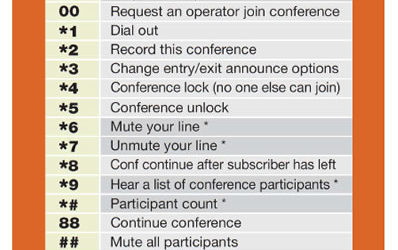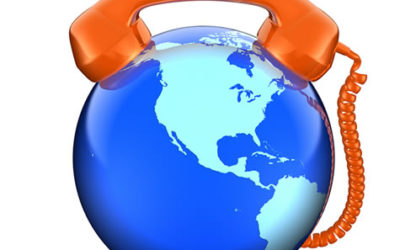Why Hold Conference Calls?
First of all, why conference calls in the first place? We all know that for many of us, it’s simply about saving travel cost. These days, it’s much more progressive than that. I think conference calls have enabled many more additional people to be involved in collaboration on difference projects that you have going on and that’s been a huge benefit. Of course, we want to save time, do things more ad hoc, more quickly, and time is money.
Really, when it comes down to it, the most important thing that we’re trying to do is just communicate more efficiently and that really wraps up everything. Let’s try to think of conference calls as much more than simply saving on travel cost.
Typical Actual Scenario
What actually happens though on conference calls? Many of you are not just attendees, but also hosts. You may have experienced these things yourself, hopefully not too frequently, but from the stories we hear it happens quite a bit.
First of all, there can be difficulties just starting the call; getting the call going. When we say difficulty, sure that could mean a real problem and the call doesn’t even start, but as a provider we think even if it’s a minute late or even if it’s a little bit of a hassle or a problem, that’s not acceptable either. I have heard many stories from customers about what a waste of time so many conference calls are, or that they’re boring. You hear all the time about people multitasking. Everyone I’m sure has his or her own horror story.
As an administrator in charge of the tool for your company, you may experience these or not. Many administrators that are involved in selecting the vendor or the provider may not be heavy call users themselves. We have to really think about the company’s clients who are experiencing this all the time, or your staff. What are they thinking in terms of your company as a whole? Are they wondering if we as a company are cutting edge? Are we really ready for 2014 if these are the hassles we’re still going through?
Problems And Frustrations
For many, conference calls ultimately end in a purely frustrating experience. People like things done a certain way for their own preferences, and when they can’t happen like that, it can be very frustrating. If calls are regularly starting a couple of minutes late, that may not seem like a big deal to some of you, but when you look at it from a macro level that is an incredible amount of wasted time.
Another aspect might be how much engagement you have throughout the call. Is there a lot of collaboration going on? Are you getting input from all of the different people involved from the call or are you only hearing from certain select people? If there is frustration and these hassles happening, what is that communicating about your company and your image?
Lost Productivity
What’s the result of all of this? Yeah, people are frustrated. People end up putting up with things that they don’t necessarily like. It’s not the case that it’s a squeaky wheel gets resolved. A lot of people just put up with things that affect their productivity quite a bit.
Over the last six months, between blog articles and some webinars, we have focused on helping you facilitate your meetings. We’ve got a lot of different meeting tips in our resources page so please check that out.
Now let’s take a minute and focus specifically on your tools because that can also make a very significant difference so let’s jump in.
What Is Your Speed?
First of all, if you think about just getting into the conference, there are often an incredible amount of steps required. Many clients look at reengineering and process engineering, so we took a similar approach and looked at a bunch of different providers in what is required to actually initiate a call. On the left side of the Adigo web conferencing platform, we’ve got different account types. We have something called a “VIP account”. That’s what you experienced when you dialed in. What you notice was that just by dialing the 800 number, you were dropped right into the conference. There is no ID required or anything else involved.
Simply dialing the number puts you directly into the conference. That is the fastest way to start a conference in the industry by far. Not only that, you also do hear a personalized prompt when the system answers, so it was branded as you heard with my name for today’s call. Timing that, we got a quick 15 seconds world record. It’s not yet in the Guinness Book, but should be in the 2014 publication, so look for that. I’m sure all of you will. Another option that is almost as speedy would be if you dialed the 800 number, but then were required to enter in an ID.
Now, many of you have probably experienced the hassle of trying to punch in 10-digit IDs. 10 digits is more than most sharp minds can remember, so here at Adigo we have made our IDs only 4 digits long. That is nice because it’s fast. It’s nice because it’s easy to remember, and it’s nice because it can be the same 4 digits as your extension; so again, making it nice and easy to remember. That simply adds 10 seconds. Even with that account type, you’re looking at only 25 seconds. Let’s jump down to the other end of the extreme. In some accounts with other providers where you may have to initiate a call via an app or a browser, that can add a significant amount of time.
Especially if you’re travelling, you can’t just dial in 800 number as the host, but you actually have to click on something. If you’re a participant and the ID is different every time, or it is indeed one of these 10-digit IDs, you have to find the invite. You have to dig through your email possibly to find the invite if it doesn’t pop up in your calendar. Maybe it’s just an email. Then, you have to hear the greeting that the system gives you and a chance to enter in the ID. Often with this long random string of 10 digits, there could be a problem, and so many providers actually force you to listen and then confirm your entry. All of these adds a lot of time.
Hopefully you get it right and the system actually recognizes it. As many of you may experience, if you’re on a mobile phone and travelling as many power users our participants are, the system won’t detect it even if you do put it in correctly, and so you may have to actually enter it in a second time.
I have some more great tips for all of you that have enjoyed the read so far. Join me Wednesday when I post Part 2 of the Generic Vanilla Conferencing Guide. If you have questions about audio conferencing, or would like to set up a free trial to test our conferencing solution, visit our free trial page or call 888-55-ADIGO.





0 Comments